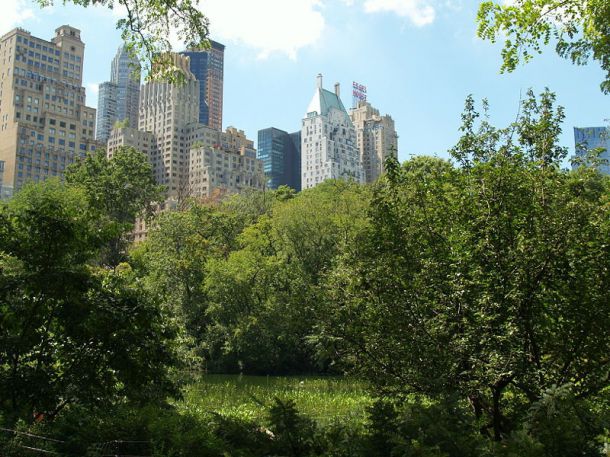
New Yorkers drive less, live in smaller apartments, use less space, and overall have a smaller ecological footprint that most other Americans. Most New Yorkers don’t own a car but rely on public transportation, many of us shop at the local farmer’s market, and visit parks – yet we can still do so much more when it comes to living green. New York International is very excited to share with you our tips for how to live green in New York City because living green is often taken for granted in New York City.What can you do to truly be a green citizen?
Start at Home
By simply following the recycling rules of your apartment complex or apartment building you can make a huge difference. Generally, this is as easy as separating the bottles, cans, paper, cardboard, and plastic from the rest of your garbage. Often times we forget to do this and if our building manager forgets to separate the garbage as well then your building certainly isn’t a green one. Don’t let that happen – start the trend of living in a green environment.How to Recycle Paper & Cardboard: The items in this category include newspapers, magazines, catalogs, white and colored paper, paper bags, envelopes, soft-cover books, telephone books, and cardboard egg cartons. You should place all paper recyclables together in clear bags or in any bin marked with green recycling decals or marked “mixed paper.”How to Recycle Beverage Cartons, Bottles, Cans, Metal & Foil: The items in this category include milk cartons, juice boxes, plastic bottles and jugs, glass bottles, metal cans, aluminum foil wraps, and bulk metal. Place these items in clear bags or in bins with a blue recyling decals or marked “bottles and cans.”For more details on how to recycle visit The New York Department of Sanitation’s website.Heat and air-condition control of your house/apartment: Many developed countries are very advanced when it comes to green buildings, and this is something New Yorkers still need to work on. If you’re renting an apartment it might be hard to change the electricity and heating use of your building, but you can always try! Many New York apartments are actually over-heated in winter. Talk to your building manager or the board. Ask for better window insulation or work on it on your own. In the summer, be respectful of your environment when using the air conditioner – never leave it running when not at home and turn the a/c down to save energy and money!Invest in energy efficient equipment – from air conditioners to refrigerators: It pays off to opt for better equipment which has been tested for its energy efficiency. Look for the Energy Star label which indicates than an appliance uses less than the amount of energy required by federal standards. Reusable Water Bottles and Coffee Cups: We love drinking coffee, but think about how often we throw the disposable cups away and get new ones. If you carry a reusable water bottle and coffee cup you can go a long way in shrinking your ecological footprint. Many coffee shops such as Starbucks offers you the opportunity to re-fill your own coffee mug. This suggestion shouldn’t be that hard to abide by. In a city filled with commuters, we carry bags all the time anyway.Re-usable Bags: Plastic bags are so easy to use because they are everywhere but imagine if everyone stopped using new plastic bags every single time they shopped? There would be way less plastic laying around if we all used the same bags over and over again. Invest in a tote bag to do all of your shopping or save the bags you already have and keep re-using them. As a matter of fact, it is a New York State Law that retailers must accept plastic bags when you feel like getting rid of them. Some stores such as Whole Foods have started giving incentives for customers to start bringing their own bags by offering a few cents credit for each re-used bag. Encourage your neighborhood store to use fewer plastic bags or to adopt an incentive plan. Avoiding plastic bags is an important part of living green in New York City because plastic comprises about 7% of the residential waste stream.Ride A Bike: In recent yearsNew York City has undertaken a huge initiative to encourage biking: hundreds of miles of bike lanes have been built, a bike share program is on its way, and new bike stands are being built. The one thing that is missing: more New Yorkers, like you, should be using these lanes! Not only is biking great for the environment, it is also great for your health. The subway and buses allow bicycles on board so there really isn’t an excuse why you shouldn’t be biking – even if you have a longer commute. With the new bike sharing system in NYC you will be able to use a bike for distances you formerly would have used a cab for.Public Transportation: There’s a reason why New Yorkers aren’t in a rush to drive their own cars: you can’t beat the speed of the public transportation available. The MTA New York City Transit System is one of the most extensive and largest public transportation systems in the world. The transit system allows you to get anywhere in the city and even outside the city as well as you can take the MTA Metro North to places like the Hudson Valley and the LIRR to Long Island.Ride and Car SharingIf you do occasionally need a car, opt for a car sharing service like Zipcar. Not only will you save on expensive parking in the city, it is really the least expensive and greenest method of using your own wheels.If you’re only taking a short trip within the city, consider ride sharing services like Uberpool and Lyft Line. By riding together, New Yorkers can help cut down on the amount of cars on the streets while saving money, leading to less traffic and a cleaner world for all of us.
Reusable Water Bottles and Coffee Cups: We love drinking coffee, but think about how often we throw the disposable cups away and get new ones. If you carry a reusable water bottle and coffee cup you can go a long way in shrinking your ecological footprint. Many coffee shops such as Starbucks offers you the opportunity to re-fill your own coffee mug. This suggestion shouldn’t be that hard to abide by. In a city filled with commuters, we carry bags all the time anyway.Re-usable Bags: Plastic bags are so easy to use because they are everywhere but imagine if everyone stopped using new plastic bags every single time they shopped? There would be way less plastic laying around if we all used the same bags over and over again. Invest in a tote bag to do all of your shopping or save the bags you already have and keep re-using them. As a matter of fact, it is a New York State Law that retailers must accept plastic bags when you feel like getting rid of them. Some stores such as Whole Foods have started giving incentives for customers to start bringing their own bags by offering a few cents credit for each re-used bag. Encourage your neighborhood store to use fewer plastic bags or to adopt an incentive plan. Avoiding plastic bags is an important part of living green in New York City because plastic comprises about 7% of the residential waste stream.Ride A Bike: In recent yearsNew York City has undertaken a huge initiative to encourage biking: hundreds of miles of bike lanes have been built, a bike share program is on its way, and new bike stands are being built. The one thing that is missing: more New Yorkers, like you, should be using these lanes! Not only is biking great for the environment, it is also great for your health. The subway and buses allow bicycles on board so there really isn’t an excuse why you shouldn’t be biking – even if you have a longer commute. With the new bike sharing system in NYC you will be able to use a bike for distances you formerly would have used a cab for.Public Transportation: There’s a reason why New Yorkers aren’t in a rush to drive their own cars: you can’t beat the speed of the public transportation available. The MTA New York City Transit System is one of the most extensive and largest public transportation systems in the world. The transit system allows you to get anywhere in the city and even outside the city as well as you can take the MTA Metro North to places like the Hudson Valley and the LIRR to Long Island.Ride and Car SharingIf you do occasionally need a car, opt for a car sharing service like Zipcar. Not only will you save on expensive parking in the city, it is really the least expensive and greenest method of using your own wheels.If you’re only taking a short trip within the city, consider ride sharing services like Uberpool and Lyft Line. By riding together, New Yorkers can help cut down on the amount of cars on the streets while saving money, leading to less traffic and a cleaner world for all of us. Electricity: By unplugging your cell phone, computer, and iPod charger when they are not being used, you conserve a great deal of energy. The same goes for your air conditioner, television, and any other electronic device in your apartment. When these devices are left plugged in, they leak energy. Another popular solution is to use a power strip and turn it off when the items are not in use. Replacing your regular light bulbs with compact fluorescent light bulbs conserves energy as well. They produce the same light level as regular bulbs but they use about a quarter of the energy and can last up to ten times longer. One thing we’re still waiting for: energy light bulbs that can be dimmed.Insulate: Insulating your home is an effective way to conserve energy. An insulated apartment/home does not gain or lose heat as quickly as a non-insulated home, so it is easier to maintain a comfortable temperature indoors (less heat/less air conditioning). In the winter you can use a plastic barrier film to cover window frames as the film traps the cold air that might come into your house when the windows are closed. According to the New York City Department of Sanitation, up to 16% of your heat can be lost through unprotected windows. In the summer, you can keep the windows closed to keep the cool air from leaving and the hot air from entering. All in all, insulating your home lowers the demand on your air conditioning and heating systems, reducing your electric bill and extending the life of the system.Living green in New York City isn’t just about helping the environment but it’s also about living healthier and saving money. In addition to recycling, unplugging your unused electronics, insulating your apartment, and walking as much as possible you can also do some of your own research and tailor living green in New York City as you see fit for yourself. Below are more resources on living green in NYC.· Con Edision: The Power of Green· NYSERDA· Grow NYC· NYC Department of Sanitation Article updated April 22, 2015
Electricity: By unplugging your cell phone, computer, and iPod charger when they are not being used, you conserve a great deal of energy. The same goes for your air conditioner, television, and any other electronic device in your apartment. When these devices are left plugged in, they leak energy. Another popular solution is to use a power strip and turn it off when the items are not in use. Replacing your regular light bulbs with compact fluorescent light bulbs conserves energy as well. They produce the same light level as regular bulbs but they use about a quarter of the energy and can last up to ten times longer. One thing we’re still waiting for: energy light bulbs that can be dimmed.Insulate: Insulating your home is an effective way to conserve energy. An insulated apartment/home does not gain or lose heat as quickly as a non-insulated home, so it is easier to maintain a comfortable temperature indoors (less heat/less air conditioning). In the winter you can use a plastic barrier film to cover window frames as the film traps the cold air that might come into your house when the windows are closed. According to the New York City Department of Sanitation, up to 16% of your heat can be lost through unprotected windows. In the summer, you can keep the windows closed to keep the cool air from leaving and the hot air from entering. All in all, insulating your home lowers the demand on your air conditioning and heating systems, reducing your electric bill and extending the life of the system.Living green in New York City isn’t just about helping the environment but it’s also about living healthier and saving money. In addition to recycling, unplugging your unused electronics, insulating your apartment, and walking as much as possible you can also do some of your own research and tailor living green in New York City as you see fit for yourself. Below are more resources on living green in NYC.· Con Edision: The Power of Green· NYSERDA· Grow NYC· NYC Department of Sanitation Article updated April 22, 2015

